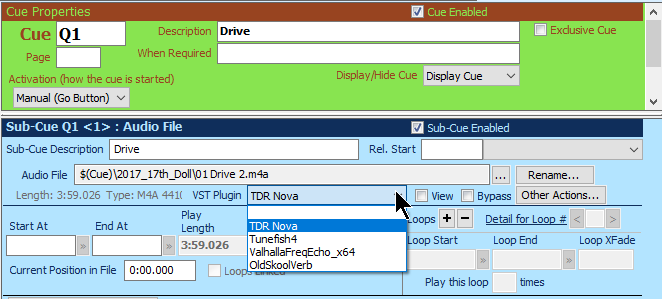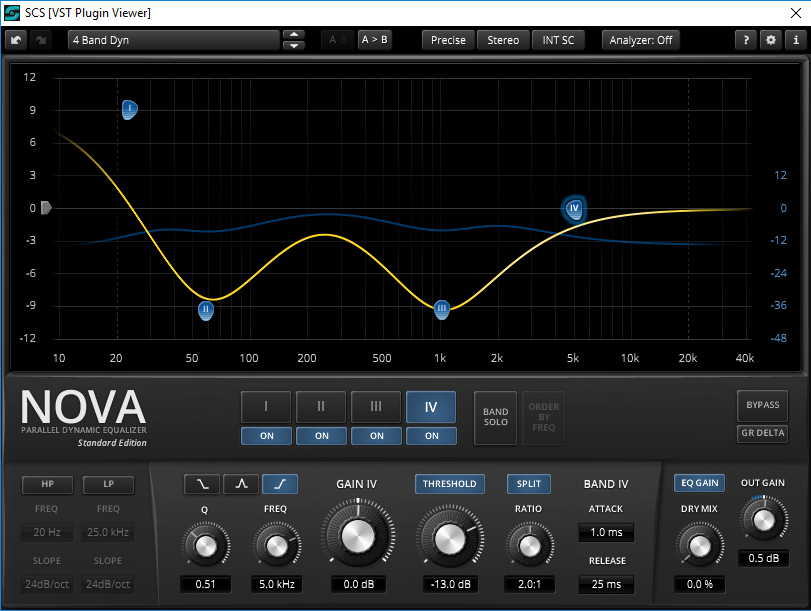
Audio File VST Plugins
VST Plugins are only available with SCS Professional Plus and higher license levels.
Overview
If at least one VST Plugin has been specified under VST Plugins then the Audio File cue display will include a field in which you can optionally select a VST Plugin to be used with this Audio File Cue. To access the VST Plugins window, click the VST Plugins button in the Main Window Toolbar.
Here's an example:

Additional Properties and Controls
VST Plugin: Select the required VST Plugin from the drop-down list, or select (or leave) blank if no VST Plugin is required for this Audio File Cue. You can alternatively select 'Same Plugin as <cue>' eg 'Same Plugin as Q27'. This is useful if you want to apply the same effect to multiple cues, and during development you need to make some adjustments to the VST effect. For example, you may have several cues for someone speaking over an intercom, so once you have recorded an actor speaking the parts, you then want to use, say, a Krush VST effect to make it sound like the speech is coming over an intercom. It may take several attempts to get the effect exactly how you want it, but by using 'Same As...' you only need to adjust the VST settings for the first of those cues and rely on 'Same as' to have that same effect applied to the other intercom cues.
View: (Not displayed if 'Same Plugin as ...' selected.) Select this checkbox to view the GUI (graphical user interface) of this plugin. See below for an example and more information. The plugin's GUI will only be displayed in the editor - it is not displayed from the main screen.
Bypass: (Not displayed if 'Same Plugin as ...' selected.) If you have a VST plugin selected but want to listen to the audio without the plugin applied then select this checkbox. Alternately selecting and de-selecting the Bypass checkbox while the audio is playing in the editor can assist in hearing the effect of the plugin. The bypass (or cancelling the bypass) may take up to a second to take effect due to buffering. Note that the state of the Bypass checkbox is saved, which means you can 'permanently' bypass the plugin for this cue without losing the link to the plugin and any program and parameter settings you have applied (see below). If you clear the Bypass checkbox later (even in a later SCS session) then the selected plugin and parameter settings will be reinstated.
Using the Plugin Viewer
When you select the View checkbox, the plugin's GUI will be displayed (assuming it has one). Here's an example using the TDR Nova plugin:

Plugins have potentially many adjustable items, including the program and parameters for that program. In the above example, the user has selected program '4 Band Dyn' and has adjusted parameters by clicking and dragging various items in the display.
When the SCS cue file is saved (ie the .scs11 file), the selected program and parameter settings are saved with other data for that Audio File Cue. So different Audio File Cues can have different VST Plugin settings, even if they use the same plugin and are played at the same time.
VST Plugins come with default settings for parameters. SCS only saves parameter settings in the cue file where the current setting is not the default setting.
If you want to undo any changes you have just made, use the SCS Undo facility.
You can drag the Plugin Viewer window to a new location and SCS will remember that location. As different plugins will have different window sizes, the stored location of the window is the top left position of the window.
To close the Plugin Viewer window, either click the window's X button or clear the View checkbox. Closing the window does not lose any settings you have applied.